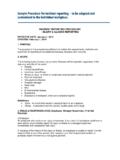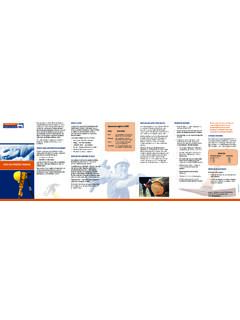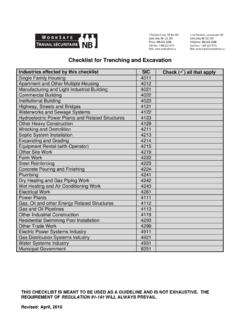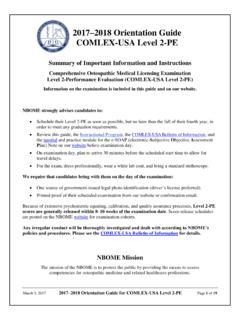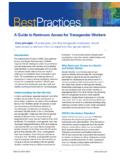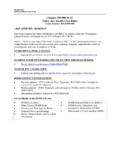Transcription of HEALTH & SAFETY ORIENTATION GUIDE for …
1 HEALTH & SAFETY ORIENTATION GUIDEfor EmployersPublished by WorkSafeNB, October 2011. Revised June | ORIENTATION GUIDE | PA G E 3 TABLE OF CONTENTSHEALTH AND SAFETY ORIENTATION WHAT YOU NEED TO KNOW 1. First Impressions are Forever ..Page 4 2. The Benefits of ORIENTATION ..Page 4 3. Who Needs an ORIENTATION Session? ..Page 5 4. Are Employers Obligated to Deliver ORIENTATION ? ..Page 5 5. ORIENTATION What is Involved? ..Page 5 6. How Do I Get Started? ..Page 7 7. How Do I Develop an ORIENTATION Session? ..Page 7 8. Who Delivers ORIENTATION in Companies? ..Page 9 ORIENTATION TOPICS 9. Topic 1 Employer Contact Information ..Page 12 10. Topic 2 Contact Information for your JHSC or H&S Representative ..Page 13 11. Topic 3 Employer and Employee Rights and Responsibilities ..Page 15 12. Topic 4 HEALTH & SAFETY Procedures and Codes of Practice Related to the Employee s Assigned Job Tasks.
2 Page 23 13. Topic 5 First Aid and Reporting Illnesses & Injuries ..Page 28 14. Topic 6 Accident/Incident Reporting Procedures ..Page 29 15. Topic 7 Emergency Preparedness Get Ready Now ..Page 31 16. Topic 8 Personal Protective Equipment ..Page 34 17. Supplementary Topics WHMIS (Workplace Hazardous Material Information System) ..Page 35 APPENDIXA ORIENTATION Overview Chart ..Page 38B Sample ORIENTATION Policy ..Page 47C Sample Right to Refuse Form ..Page 49D Sample Working Alone Policy ..Page 51E Sample PPE Policy ..Page 53F PPE Selection Eye and Face Protection, Respirators ..Page 55G Sample WHMIS SAFETY Audit ..Page 57H Sample Risk Assessment Chart ..Page 60I Injury and Incident Reporting ..Page 63J Sample Selection Guidelines for PPE ..Page 64K First Aid/Accident Reporting ORIENTATION Review ..Page 67L Emergency Preparedness Checklist for New Employees.
3 Page 68M Joint HEALTH and SAFETY Committee ORIENTATION Information ..Page 70 TABLE OF CONTENTSPA G E 4 | ORIENTATION GUIDE | WorkSafeNBHEALTH AND SAFETY ORIENTATION : WHAT YOU NEED TO KNOWH ealth and SAFETY ORIENTATION is a vital component of any company s HEALTH and SAFETY management system. It is the process of introducing new, inexperienced, transferred and returning employees to a safe and healthy workplace. ORIENTATION provides employees with necessary SAFETY information about their job and tasks, informs them of specific details about workplace hazards and provides an opportunity to learn about the company and their colleagues, ask questions and to clarify new or confusing New Brunswick, all employers are required to provide new employees with ORIENTATION before they begin work at the workplace as well as job specific training. This GUIDE assists employers with developing their ORIENTATION FIRST IMPRESSIONS ARE FOREVERToo many times companies rush through ORIENTATION not realizing employees have different comfort levels with their new job, bring different experiences to the job and have different learning needs.
4 ORIENTATION is not meant to be a checklist task it is an employee s first impression of the management system and the overall workplace culture. New employees starting with any company will have expectations about the workplace culture and the emphasis on the SAFETY ORIENTATION they receive will be reflected in their work performance, their eagerness to learn and their willingness to contribute to a safe and healthy workplace. 2. THE BENEFITS OF ORIENTATIONThe benefits of providing new employees with a comprehensive ORIENTATION are numerous: Employees become aware of the HEALTH and SAFETY hazards on the job, controls for these hazards and how they can affect their SAFETY and the SAFETY of others. Helps reduce the risk of potential injuries and accidents. Meets legislative requirements (demonstrates due diligence). Helps balance the company s need for productivity with the employee s need for SAFETY and security.
5 Increases efficiency of the new employee. Contributes to building a retention culture within the organization, thereby reducing turnover. Demonstrates the company s moral obligation to protect the employee from AND SAFETY ORIENTATION : WHAT YOU NEED TO KNOWWorkSafeNB | ORIENTATION GUIDE | PA G E 5 HEALTH AND SAFETY ORIENTATION : WHAT YOU NEED TO KNOW3. WHO NEEDS AN ORIENTATION SESSION?All new employees who meet any of the following definitions need an ORIENTATION . The Occupational HEALTH and SAFETY (OHS) Act defines new employees as any person who is: New to a position or place of employment. Returning to a position or place of employment in which hazards have changed during the employee s absence. Under 25 years of age and returning to a position or place of employment after an absence of more than six months.
6 Affected by a change in the hazards of a place of ARE EMPLOYERS OBLIGATED TO DELIVER ORIENTATION ?In short, yes. The OHS Act came into force in New Brunswick in 1983 and provides the basic framework for making New Brunswick workplaces safe and healthy for employees. It: Fosters the Internal Responsibility System (IRS) by requiring employers to provide for a healthy and safe workplace, making them directly responsible for implementing and monitoring HEALTH and SAFETY . Imposes both general and specific duties on all workplace parties to exercise HEALTH and SAFETY practices. Gives employees three basic rights: the right to know about hazards on the job; the right to participate in HEALTH and SAFETY initiatives; and, the right to refuse unsafe work. Sets out penalties for non-compliance of legislative standards and provides WorkSafeNB s HEALTH and SAFETY officers the power to inspect workplaces, investigate workplace complaints, investigate workplace accidents and issue orders for addition, amendments to the Act in 2014 provide the requirement that a new employee must receive ORIENTATION to the position and place of employment before beginning work [OHS Act, subsection (2)].
7 As well, they must receive job specific training if required (for example, lift truck operator certification).5. ORIENTATION WHAT IS INVOLVED?The two questions asked most often about ORIENTATION are: How long should ORIENTATION take? and What should I cover during the ORIENTATION session(s)? The length of time required for ORIENTATION cannot be defined, as it will depend on the workplace, and the specific job and tasks. ORIENTATION should not consist of a whirlwind of checklists and SAFETY manuals handed to the new employee, but rather needs to be practical and hands-on, and should focus on the skills the employee must develop to be successful at their G E 6 | ORIENTATION GUIDE | WorkSafeNBHEALTH AND SAFETY ORIENTATION : WHAT YOU NEED TO KNOWORIENTATION TOPICSThe following eight topics are the minimum requirement for organizations to review with new employees before they begin work: 1.
8 Contact Information: Names, phone numbers, fax numbers, pager number of employee s supervisor and company personnel, including emergency contact Joint HEALTH and SAFETY Committee (JHSC) or SAFETY Representative: Introduce the employee to the committee members or the SAFETY representative (along with their contact information) and outline the JHSC s or SAFETY rep s role in helping management maintain a healthy and safe workplace. 3. Rights and Responsibilities: Explain both the employee and employer responsibilities as outlined in both the OHS Act and Workers Compensation (WC) Act. Specific information includes: - Reporting of accidents - Reporting unsafe working conditions - Process for exercising their right to refuse unsafe work4. Procedures and Codes of Practice: Explain the company s procedures and codes of practice as it pertains to the employee s job and department.
9 Outline the expectations for the employee and the employee s supervisor to adhere to all First Aid: Introduce first aid providers, indicate areas for first aid kits or room, explain to employees how to summon first aid for themselves or for a Accident/Injury Reporting Procedures: Explain the established company procedure and contact people for reporting any injuries sustained by the Emergency Procedures and Preparedness: Review the company s emergency personnel contact info; evacuation plan, including exit routes; evacuation signals and sirens; location of eyewash stations and showers, fire extinguishers, and alarm pull boxes; identify fire marshal(s); and identify exposures. Other procedures may include: - Bomb threats/suspicious packages - Threatening, violent or disruptive behaviours - Chemical spills, gas leaks - Debriefing assistance for critical incidents8.
10 Personal Protective Equipment (PPE): Review the required PPE (legal) standards for specific jobs or job tasks, including the appropriate use, fitting, storage, and maintenance for assigned topic areas may also need to be included in the ORIENTATION information. Two common topics that you may want to include are: Code of Practice for Working Alone: Outline the process for any employee who works alone so they can remain safe on the job or to be able to summon emergency assistance, if required. Workplace Hazardous Material Information System (WHMIS): Explain where hazardous material and substances are located and review the labeling system, hazardous symbols and location and contents of the Material SAFETY Data Sheets (MSDS). Train employees on site-specific products and accompanying MSDS | ORIENTATION GUIDE | PA G E 7 HEALTH AND SAFETY ORIENTATION : WHAT YOU NEED TO KNOW6.

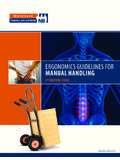
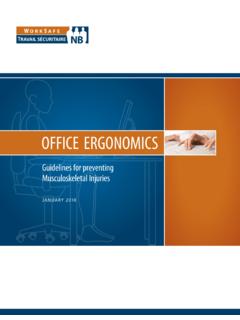
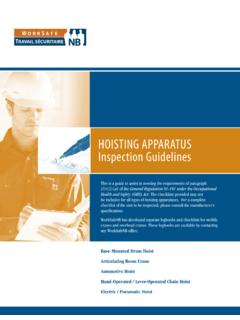
![SAFETY TALK [hearing protection] - WorkSafeNB – …](/cache/preview/3/4/b/8/d/f/0/4/thumb-34b8df04d33dcf40e26b345789106441.jpg)
